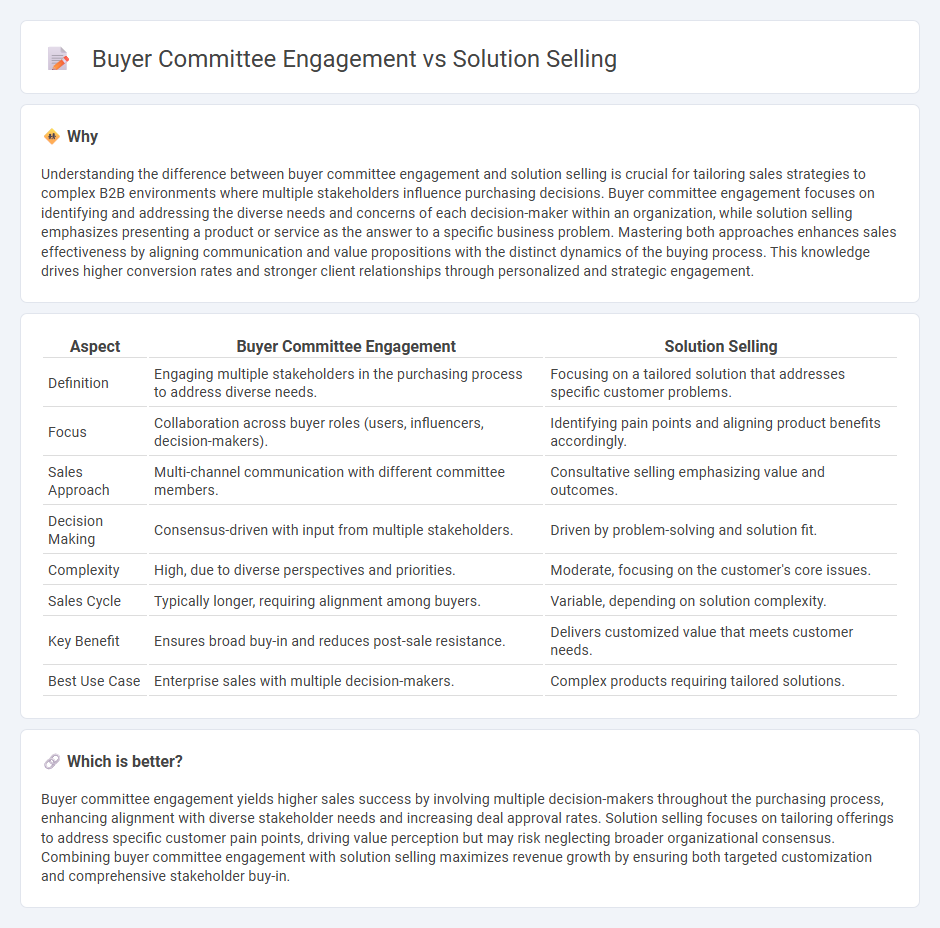
Buyer committee engagement focuses on understanding the diverse roles and priorities within a decision-making group to tailor sales strategies effectively. Solution selling emphasizes identifying specific client problems and delivering tailored offerings that address those needs directly. Discover how integrating both approaches can enhance sales effectiveness and close rates.
Why it is important
Understanding the difference between buyer committee engagement and solution selling is crucial for tailoring sales strategies to complex B2B environments where multiple stakeholders influence purchasing decisions. Buyer committee engagement focuses on identifying and addressing the diverse needs and concerns of each decision-maker within an organization, while solution selling emphasizes presenting a product or service as the answer to a specific business problem. Mastering both approaches enhances sales effectiveness by aligning communication and value propositions with the distinct dynamics of the buying process. This knowledge drives higher conversion rates and stronger client relationships through personalized and strategic engagement.
Comparison Table
| Aspect | Buyer Committee Engagement | Solution Selling |
|---|---|---|
| Definition | Engaging multiple stakeholders in the purchasing process to address diverse needs. | Focusing on a tailored solution that addresses specific customer problems. |
| Focus | Collaboration across buyer roles (users, influencers, decision-makers). | Identifying pain points and aligning product benefits accordingly. |
| Sales Approach | Multi-channel communication with different committee members. | Consultative selling emphasizing value and outcomes. |
| Decision Making | Consensus-driven with input from multiple stakeholders. | Driven by problem-solving and solution fit. |
| Complexity | High, due to diverse perspectives and priorities. | Moderate, focusing on the customer's core issues. |
| Sales Cycle | Typically longer, requiring alignment among buyers. | Variable, depending on solution complexity. |
| Key Benefit | Ensures broad buy-in and reduces post-sale resistance. | Delivers customized value that meets customer needs. |
| Best Use Case | Enterprise sales with multiple decision-makers. | Complex products requiring tailored solutions. |
Which is better?
Buyer committee engagement yields higher sales success by involving multiple decision-makers throughout the purchasing process, enhancing alignment with diverse stakeholder needs and increasing deal approval rates. Solution selling focuses on tailoring offerings to address specific customer pain points, driving value perception but may risk neglecting broader organizational consensus. Combining buyer committee engagement with solution selling maximizes revenue growth by ensuring both targeted customization and comprehensive stakeholder buy-in.
Connection
Buyer committee engagement enhances solution selling by ensuring that all decision-makers' needs and concerns are addressed throughout the sales process. Understanding the diverse roles and priorities within the buyer committee allows sales teams to tailor value propositions and demonstrate how the solution meets specific business objectives. This alignment fosters trust and accelerates deal closure by positioning the solution as a strategic fit for the entire organization.
Key Terms
**Solution selling:**
Solution selling emphasizes understanding a buyer's specific needs and tailoring offerings to address those pain points, leading to higher customer satisfaction and increased sales effectiveness. This approach relies on deep product knowledge and consultative interactions to demonstrate clear value propositions that resonate with decision-makers. Explore how mastering solution selling can transform your sales strategy and drive revenue growth.
Needs Assessment
Solution selling emphasizes understanding and addressing the specific needs and pain points of potential clients through in-depth Needs Assessment, enabling tailored value propositions that resonate with buyers. Buyer committee engagement requires collaboration and alignment across multiple stakeholders, ensuring that the diverse needs and concerns within the committee are thoroughly assessed and addressed to achieve consensus. Explore how mastering Needs Assessment in both approaches can drive successful sales outcomes and stronger buyer relationships.
Value Proposition
Solution selling emphasizes tailoring the value proposition to address specific customer pain points and outcomes, ensuring that the benefits resonate with individual decision-makers. Buyer committee engagement requires aligning the value proposition across diverse stakeholder priorities, facilitating consensus and highlighting the multifaceted impact on the organization. Explore how refining your value proposition can drive successful solution selling and buyer committee alignment.
Source and External Links
Value Selling vs. Solution Selling: Why Value Wins - Solution selling is a methodology that focuses on positioning products or services as tailored solutions to specific customer pain points, emphasizing matching features to customer needs and solving immediate challenges.
What Is Solution Selling? Pros, Cons, and Tips for Entrepreneurs - Solution selling is a customer-centric sales strategy that evaluates and recommends products or services based on solving customer pain points, requiring deep understanding of the client's problem before proposing a solution.
Solution Selling: What It Is & How to Do It Effectively - Solution selling involves a process of prospecting, qualifying, discovering needs, adding value, presenting custom solutions, and closing deals, aimed at providing tailored solutions that demonstrate measurable return on investment.
 dowidth.com
dowidth.com